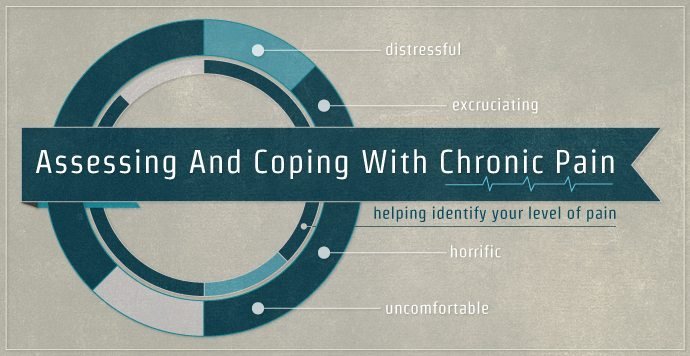Assessing And Coping With Chronic Pain

Assessing Pain and Working with Your Health Recovery Team: If you think you have chronic pain or if you have been diagnosed with this condition, there are numerous pain charts that can help you to identify your level of pain and suffering. You can find these online or sites such as The American Chronic Pain Association or even at sites dedicated to a specific pain condition, such as fibromyalgia.
These sites also include a variety of tools for gauging related issues such as stress scales, mood logs, and activity logs. You can also use our scale which is based on standard 0 – 10 scales with 0 = no pain and 10 = excruciating pain.
- 0 = no pain: Feel good physically. This is the baseline for examining pain conditions.
- 1 = minor pain: Everyone has experienced minor pain. It is so minor we might barely notice it, such as a small bruise or a mosquito bite.
- 2 = mild: This might be a deeper bruise, a small cut, a knee banged on the furniture. This is manageable pain that usually doesn’t require medical intervention.
- 3 = discomforting pain: Pain such as a deeper cut, aches and pains of a fever, or wrist sprain. You recognize the pain and it may be persistent. In fact, you may need medical attention, such as an over-the-counter pain reliever.
- 4 = moderate pain: Pain that stays with you, such as strained back muscles, headaches, and fibromyalgia. It causes interruption to your daily activities and may benefit from medical intervention as well as integrative health practices.
- 5 = distressful: May include the above conditions, but the pain is so uncomfortable that daily activities are not being completed and you may begin to feel you are suffering.
- 6 = intense pain: May include the level of pain you’d feel from a broken leg, a flare-up of fibromyalgia, on cancer pain. This pain level is becoming unmanageable and needs signification medical/CAM treatment. Daily living tasks are mostly unmet and your thought process becomes impaired as your focus revolves around your pain.
- 7 = terrible pain: As above, but dominates your day and stops you from participating in any activities. In severe cases, you may be bed ridden. You will probably need pain medication at this point. This type of pain includes migraine headaches, a torn ACL or MCL, increasing cancer pain, or a herniated disk.
- 8 = horrific: This is a level of pain that may include the above medical conditions and occurs during the pain of childbirth, the passing of a kidney stone, and with late stage cancer pain. Medication is needed at this time. Sadly, the pain is so unbearable that your entire life is affected and you are bedridden and fearful. You may start to have suicidal thoughts as living in this level of pain is unacceptable to your quality of life.
- 9 – 10 = excruciating pain: These levels are pain conditions that most people never experience such as horrific burns, amputations, and damaged nerves. They may result in loss of consciousness as the body cannot control this pain. These conditions are totally disabling.

In exploring pain vs. suffering, we must honestly appraise the pain condition, as it is common to overrate pain. If we have nothing to compare our pain to we tend to overrate it because it is a higher level for ourselves. When seeing people who rate their pain at 9-10 but can lives their lives (walking, talking, moving, attending work, etc), they are likely inadvertently exaggerating.
They aren’t being dishonest, but 1) they don’t understand pain, 2) they want to convey to the practitioner how much they are suffering, and 3) they are relating the suffering along with the pain. While suffering must be addressed, it is important to assess this independently as suffering requires other treatments.
Suffering is related to the quality of life (please again refer to the above websites for a quality of life chart). However, given the above information, assessing pain and suffering is subjective and only the patient can assess this for themselves.
Also remember that other conditions such as substance abuse, depression, anxiety, and stress further complicate recovery from chronic pain. Also, many pain medications are habit-forming and may lead to addictions or are counter-indicated in people with substance use disorders. (Please refer to the article: Chronic Pain: Mental Health, Addictions and Co-Occurring Disorders)
It’s very important for you to work with a medical/health recovery team to help you to best cope with your pain. Pain and suffering can be treated effectively and those with long-term chronic pain must develop a working relationship with their recovery team in order to have the highest quality of life possible within the pain conditions.
This team may consist of:
- Physician (such as an MD or DO or Internal Medicine Doctor) who may provide medication treatment and suggestions for further help)
- Chronic Pain Specialist (such as a Pain Clinic or Physiatrist – who may provide medication as well as exploring healthy recovery techniques)
- Psychiatrist (for mental health and/or substance use problems and the need for psychiatric medications)
- Neurologist
- Rheumatologist
- Social Worker or Counselor (to talk about your pain, grief, stress, and other issues such as mental health issues and substance use problems)
- Addiction Treatment Facility or Mental Health Facility (if you need specialized treatment in an inpatient setting)
- Complementary and Alternative Medicine (CAM) Practitioners:
- Dietitian/Nutritionist
- Sleep Specialist
- Acupuncture
- Chiropractic
- Massage Therapy
- Physical and Occupational Therapy
- Biofeedback
- Dietary and Herbal Supplements (such as vitamins, glucosamine chondroitin, and aloe vera, but you must talk with your primary physician about supplements as they can negatively impact traditional medications)
Other practices (may or may not need professional guidance):
- Exercise
- Healthy eating and sleep hygiene
- Meditation
- Yoga
- Tai chi
- Swimming
- Guided imagery
- Positive affirmations
- Reiki and other energy work
- Electrical stimulation such as a TENS unit
- Relaxation exercises
- Essential oils
- Spiritual and/or religious practices
- Contacting your support persons
- Participating in support groups for your condition or a 12-step group for chronic pain
- Educate yourself about pain and healing
- Journaling
- Hobbies/Creative activities
Medication Treatment may include over-the-counter meds such as acetaminophen, ibuprofen, and aspirin. Antidepressants and antiepileptic meds also help with some forms of pain such as neuropathic pain as well as aid in the treatment of depression which is often found in chronic-pain patients.
These may include Elavil, Desyrel, Cymbalta, Neurontin, Tegretol and Lyrica. Also, a number of opioids are very helpful, such as Norco, Vicodin, Oxycodone, methadone, and Fentanyl, although they can be addictive and decrease the body’s ability to formulate the natural opiates within the body. You must have an open relationship with the prescribing physician regarding the use of medications.
We will further focus on healing for chronic pain in the article, Chronic Pain: The Wheel of Recovery.




